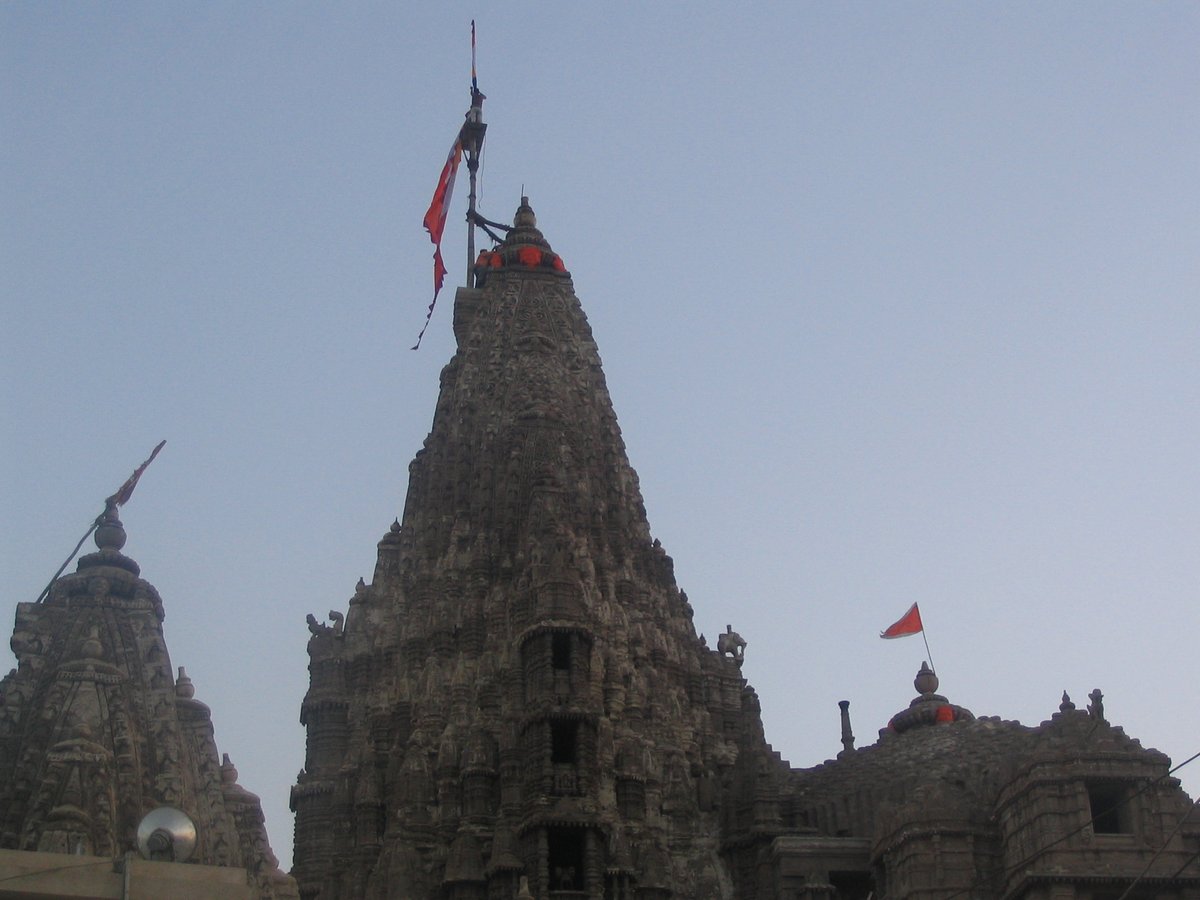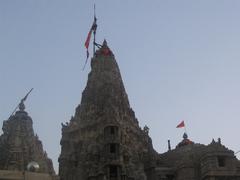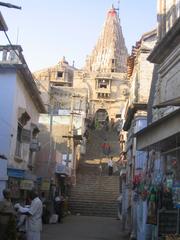
Comprehensive Guide to Visiting Dwarkadhish Temple, Dwarka, India
Date: 16/07/2024
Introduction
The Dwarkadhish Temple, also known as the Jagat Mandir, stands as one of India’s most revered and culturally significant Hindu temples. Located in the ancient city of Dwarka, Gujarat, this monumental structure is dedicated to Lord Krishna, worshipped here as the ‘King of Dwarka’ or ‘Dwarkadhish.’ The temple’s origins are deeply intertwined with Hindu mythology, particularly the Mahabharata and the Puranas, where it is believed that Lord Krishna established the city of Dwarka after leaving Mathura to escape repeated attacks by Jarasandha, the king of Magadha (Dwarkadhish Temple Official Website). Dwarka, often referred to as the ‘Golden City,’ was famed for its prosperity and architectural grandeur.
Over the centuries, the Dwarkadhish Temple has undergone several reconstructions and renovations due to natural calamities and invasions, with its current structure believed to date back 2,200 to 2,500 years. The temple is a prime example of Chalukya-style architecture, featuring intricate carvings, towering spires, and a grand entrance. The main shrine houses an idol of Lord Krishna, said to have been installed by his great-grandson, Vajranabha. The temple is not only an architectural marvel but also a vital cultural and religious center, attracting millions of devotees annually, especially during the Janmashtami festival, which celebrates the birth of Lord Krishna (Archaeological Survey of India).
For visitors, the Dwarkadhish Temple offers a unique blend of spiritual and historical experiences. The temple is open from 6:30 AM to 1:00 PM and from 5:00 PM to 9:30 PM, with no entry fee, though donations are welcomed. The best time to visit is between November and February when the weather is most pleasant. Visitors are advised to dress modestly and respect the temple’s sanctity. Guided tours are available for those interested in a deeper understanding of the temple’s history and architecture (Gujarat Tourism).
Table of Contents
- Ancient Origins and Mythological Significance
- Historical Construction and Architectural Evolution
- Cultural and Religious Significance
- Visitor Information
- Travel Tips
- Nearby Attractions
- Archaeological and Historical Research
- Modern-Day Significance and Preservation Efforts
- Frequently Asked Questions (FAQ)
Ancient Origins and Mythological Significance
The temple’s origins are deeply rooted in Hindu mythology, particularly the Mahabharata and the Puranas. According to legend, the city of Dwarka was established by Lord Krishna after he left Mathura to escape the repeated attacks by Jarasandha, the king of Magadha. Dwarka is believed to have been a well-planned city, often referred to as the “Golden City” due to its prosperity and grandeur.
Historical Construction and Architectural Evolution
The current structure of the Dwarkadhish Temple is believed to have been constructed around 2,200 to 2,500 years ago. However, the temple has undergone several reconstructions and renovations over the centuries due to natural calamities and invasions. The temple’s architecture is a fine example of the Chalukya style, characterized by intricate carvings, towering spires, and a grand entrance.
The main shrine, or Garbhagriha, houses the idol of Lord Krishna, which is said to have been installed by Vajranabha, the great-grandson of Krishna. The temple complex also includes several smaller shrines dedicated to other deities, including Balarama, Subhadra, and Rukmini. The temple’s five-story structure is supported by 72 pillars, and the spire rises to a height of about 78.3 meters (256 feet), making it a prominent landmark in the city.
Historical Events and Renovations
Throughout its history, the Dwarkadhish Temple has witnessed numerous significant events and renovations. One of the most notable reconstructions occurred in the 16th century under the patronage of the Gaekwads of Baroda. The temple was also renovated in the 19th century by the Maharaja of Baroda, Sayajirao Gaekwad III, who contributed significantly to its restoration and maintenance.
The temple has also faced challenges, including attacks by Mahmud Begada, the Sultan of Gujarat, in the 15th century. Despite these adversities, the temple has been meticulously restored each time, preserving its historical and religious significance.
Cultural and Religious Significance
The Dwarkadhish Temple holds immense cultural and religious significance for Hindus. It is one of the Char Dham pilgrimage sites, which also include Badrinath, Puri, and Rameswaram. Pilgrims believe that visiting these four sacred sites can help attain Moksha, or liberation from the cycle of birth and death.
The temple is also part of the Sapta Puri, the seven holy cities of Hinduism, which are considered the most sacred pilgrimage destinations. The annual Janmashtami festival, celebrating the birth of Lord Krishna, is one of the most significant events at the temple, attracting thousands of devotees from across the country and the world.
Visitor Information
Visiting Hours: The Dwarkadhish Temple is open to visitors from 6:30 AM to 1:00 PM and from 5:00 PM to 9:30 PM. The temple can get quite crowded during major festivals and weekends, so plan your visit accordingly.
Tickets: There is no entry fee for the Dwarkadhish Temple. However, donations are welcome and go towards the maintenance and preservation of the temple.
Travel Tips
- Best Time to Visit: The best time to visit Dwarka is between November and February when the weather is pleasant. Avoid the monsoon season as heavy rains can cause inconvenience.
- Dress Code: Modest attire is required for both men and women. It is advisable to wear traditional Indian clothing or cover your shoulders and knees.
- Photography: Photography is allowed in the temple premises but is restricted in the inner sanctum (Garbhagriha).
- Guided Tours: Guided tours are available and can be booked through the temple’s official website or local tour operators.
Nearby Attractions
- Nageshwar Jyotirlinga Temple: One of the twelve Jyotirlinga shrines dedicated to Lord Shiva, located about 17 km from Dwarka.
- Bet Dwarka: An island believed to be the original residence of Lord Krishna, accessible by a short boat ride from Okha.
- Rukmini Devi Temple: A temple dedicated to Rukmini, the consort of Lord Krishna, located about 2 km from Dwarka.
Archaeological and Historical Research
Archaeological excavations in and around Dwarka have provided valuable insights into the city’s ancient past. Underwater explorations have revealed submerged structures and artifacts, suggesting that parts of the ancient city may have been submerged due to rising sea levels or other natural phenomena. These findings have sparked significant interest among historians and archaeologists, contributing to the ongoing research on the historical and cultural heritage of Dwarka.
Modern-Day Significance and Preservation Efforts
Today, the Dwarkadhish Temple continues to be a major pilgrimage site and a symbol of India’s rich cultural and religious heritage. The temple is managed by the Dwarka Devasthan Samiti, which oversees its maintenance, rituals, and festivals. Efforts are also being made to preserve and promote the temple’s historical and architectural significance through various initiatives, including digital documentation and heritage conservation projects.
The temple’s significance extends beyond its religious importance, as it also plays a crucial role in the local economy by attracting tourists and pilgrims. The Gujarat Tourism Department has been actively promoting Dwarka as a key destination, enhancing infrastructure and facilities to accommodate the growing number of visitors.
FAQ
Q: What are the Dwarkadhish Temple visiting hours?
A: The temple is open from 6:30 AM to 1:00 PM and from 5:00 PM to 9:30 PM.
Q: Is there an entry fee for the Dwarkadhish Temple?
A: No, there is no entry fee, but donations are welcome.
Q: What is the best time to visit Dwarka?
A: The best time to visit is between November and February.
Q: Are guided tours available for the Dwarkadhish Temple?
A: Yes, guided tours are available and can be booked through the temple’s official website or local tour operators.
Q: What are some nearby attractions to the Dwarkadhish Temple?
A: Nearby attractions include Nageshwar Jyotirlinga Temple, Bet Dwarka, and Rukmini Devi Temple.
Conclusion
In conclusion, the Dwarkadhish Temple is not just a place of worship but a cornerstone of India’s rich cultural and religious heritage. Its intricate Chalukya architecture, historical significance, and vibrant rituals make it a must-visit destination for both devotees and tourists. Over the centuries, the temple has stood resilient against invasions and natural calamities, thanks to meticulous restoration efforts by various patrons, including the Gaekwads of Baroda. Today, the temple continues to draw millions of visitors, contributing significantly to the local economy and cultural landscape of Dwarka (Dwarkadhish Temple Official Website).
The temple’s importance extends beyond its religious significance; it plays a crucial role in the ongoing archaeological research that seeks to uncover more about Dwarka’s ancient past. Underwater explorations have revealed submerged structures and artifacts, further enriching our understanding of this fabled city (Archaeological Survey of India). As efforts to preserve and promote the temple’s historical and architectural heritage continue, the Dwarkadhish Temple remains a timeless symbol of devotion, resilience, and architectural brilliance.
For those planning to visit, the temple offers a comprehensive spiritual journey, enriched by nearby attractions like the Nageshwar Jyotirlinga Temple, Bet Dwarka, and the Rukmini Devi Temple. With its robust visitor amenities and detailed guided tours, the Dwarkadhish Temple ensures a fulfilling and memorable experience for all. For more information and updates, visitors are encouraged to follow the temple’s official channels and download the Audiala mobile app (Gujarat Tourism).


